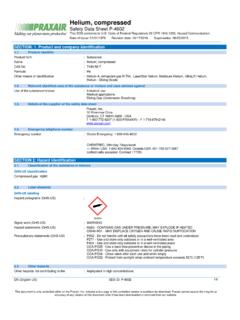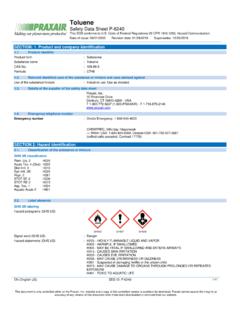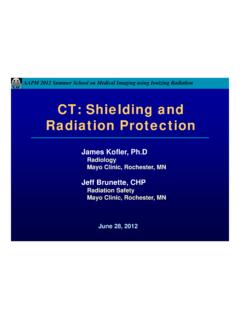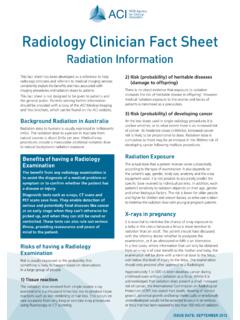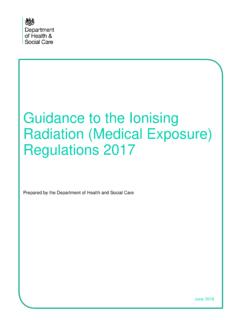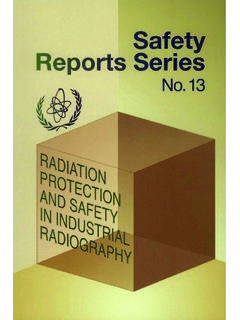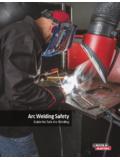Transcription of Chlorine Gas Safety Data Sheet SDS P4580
1 Chlorine Safety data Sheet P-4580 This SDS conforms to Code of Federal Regulations 29 CFR , Hazard Communication. Date of issue: 01/01/1979 Revision date: 11/30/2016 Supersedes: 10/17/2016 EN (English US) SDS ID: P-4580 1/10 This document is only controlled while on the Praxair, Inc. website and a copy of this controlled version is available for download. Praxair cannot assure the integrity or accuracy of any version of this document after it has been downloaded or removed from our website. SECTION: 1. Product and company identification Product identifier Product form : Substance Name : Chlorine CAS No : 7782-50-5 Formula : Cl2 Relevant identified uses of the substance or mixture and uses advised against Use of the substance/mixture : Industrial use.
2 Use as directed. Details of the supplier of the Safety data Sheet Praxair, Inc. 10 Riverview Drive Danbury, CT 06810-6268 - USA T 1-800-772-9247 (1-800-PRAXAIR) - F 1-716-879-2146 Emergency telephone number Emergency number : Onsite Emergency: 1-800-645-4633 CHEMTREC, 24hr/day 7days/week Within USA: 1-800-424-9300, Outside USA: 001-703-527-3887 (collect calls accepted, Contract 17729) SECTION 2: Hazard identification Classification of the substance or mixture GHS-US classification Ox. Gas 1 H270 Liquefied gas H280 Acute Tox. 2 (Inhalation: gas) H330 Skin Corr. 1A H314 Eye Dam. 1 H318 STOT SE 3 H335 Aquatic Acute 1 H400 Label elements GHS-US labeling Hazard pictograms (GHS-US) : GHS03 GHS04 GHS05 GHS06 GHS07 GHS09 Signal word (GHS-US) : DANGER Hazard statements (GHS-US) : H270 - MAY CAUSE OR INTENSIFY FIRE; OXIDIZER H280 - CONTAINS GAS UNDER PRESSURE.
3 MAY EXPLODE IF HEATED H314 - CAUSES SEVERE SKIN BURNS AND EYE DAMAGE H330 - FATAL IF INHALED H400 - VERY TOXIC TO AQUATIC LIFE CGA-HG22 - CORROSIVE TO THE RESPIRATORY TRACT Precautionary statements (GHS-US) : P202 - Do not handle until all Safety precautions have been read and understood P244 - Keep reduction valves/valves and fittings free from oil and grease P260 - Do not breathe gas P264 - Wash hands thoroughly after handling P271+P403 - Use and store only outdoors or in a well-ventilated place P273 - Avoid release to the environment Chlorine Safety data Sheet P-4580 This SDS conforms to Code of Federal Regulations 29 CFR , Hazard Communication.
4 Date of issue: 01/01/1979 Revision date: 11/30/2016 Supersedes: 10/17/2016 EN (English US) SDS ID: P-4580 2/10 This document is only controlled while on the Praxair, Inc. website and a copy of this controlled version is available for download. Praxair cannot assure the integrity or accuracy of any version of this document after it has been downloaded or removed from our website. P280+P284 - Wear protective gloves, protective clothing, eye protection , respiratory protection , and/or face protection P370+P376 - In case of fire: Stop leak if safe to do so P405 - Store locked up P501 - Dispose of contents/container Dispose in a safe manner in accordance with local/national regulations CGA-PG05 - Use a back flow preventive device in the piping CGA-PG20+CGA-PG10 - Use only with equipment of compatible materials of construction and rated for cylinder pressure CGA-PG12 - Do not open valve until connected to equipment prepared for use CGA-PG18 - When returning cylinder.
5 Install leak tight valve outlet cap or plug CGA-PG06 - Close valve after each use and when empty CGA-PG02 - Protect from sunlight when ambient temperature exceeds 52 C (125 F) Other hazards Other hazards not contributing to the classification : None. Unknown acute toxicity (GHS US) No data available SECTION 3: Composition/Information on ingredients Substance Name Product identifier % Chlorine (Main constituent) (CAS No) 7782-50-5 100 Mixture Not applicable SECTION 4: First aid measures Description of first aid measures First-aid measures after inhalation : Remove to fresh air and keep at rest in a position comfortable for breathing.
6 If not breathing, give artificial respiration. If breathing is difficult, trained personnel should give oxygen. Call a physician.. WARNING: To avoid possible chemical burns, the rescuer should avoid breathing any exhaled air from the victim. First-aid measures after skin contact : Avoid breathing vapors. In case of contact, immediately flush affected areas with plenty of water for at least 15 minutes while removing contaminated clothing and shoes. Call a physician. Wash clothing before reuse. Discard contaminated shoes. First-aid measures after eye contact : Immediately flush eyes thoroughly with water for at least 15 minutes.
7 Hold the eyelids open and away from the eyeballs to ensure that all surfaces are flushed thoroughly. Contact an ophthalmologist immediately. First-aid measures after ingestion : Ingestion is not considered a potential route of exposure. Most important symptoms and effects, both acute and delayed Symptoms/injuries after inhalation : Overexposure to concentrations moderately above the TLV of 1 ppm irritates the eyes and respiratory tract. Very brief exposure to a concentration of 1000 ppm may be fatal. Acts as an asphyxiant at high concentrations. Inhalation of high concentrations ( , greater than 15 ppm) causes choking, coughing, burning of the throat, and severe irritation of the upper respiratory tract; additionally, pulmonary edema, bronchitis, and pneumonitis may result.
8 Indication of any immediate medical attention and special treatment needed Obtain medical assistance. SECTION 5: Firefighting measures Extinguishing media Suitable extinguishing media : Use extinguishing media appropriate for surrounding fire. Special hazards arising from the substance or mixture Fire hazard : Oxidizer. May accelerate the burning of other combustible materials. Reactivity : No reactivity hazard other than the effects described in sub-sections below. Chlorine Safety data Sheet P-4580 This SDS conforms to Code of Federal Regulations 29 CFR , Hazard Communication. Date of issue: 01/01/1979 Revision date: 11/30/2016 Supersedes: 10/17/2016 EN (English US) SDS ID: P-4580 3/10 This document is only controlled while on the Praxair, Inc.
9 Website and a copy of this controlled version is available for download. Praxair cannot assure the integrity or accuracy of any version of this document after it has been downloaded or removed from our website. Advice for firefighters Firefighting instructions : Evacuate all personnel from the danger area. Use self-contained breathing apparatus (SCBA) and protective clothing. Immediately cool containers with water from maximum distance. Stop flow of gas if safe to do so, while continuing cooling water spray. Remove ignition sources if safe to do so. Remove containers from area of fire if safe to do so.
10 On-site fire brigades must comply with OSHA 29 CFR and applicable standards under 29 CFR 1910 Subpart L Fire protection . protection during firefighting : DANGER! Toxic, corrosive, high-pressure Special protective equipment for fire fighters : Standard protective clothing and equipment (Self Contained Breathing Apparatus) for fire fighters. Specific methods : Use fire control measures appropriate for the surrounding fire. Exposure to fire and heat radiation may cause gas containers to rupture. Cool endangered containers with water spray jet from a protected position. Prevent water used in emergency cases from entering sewers and drainage systems Stop flow of product if safe to do so Use water spray or fog to knock down fire fumes if possible.
